The Importance of Kite Surfing Vests in Kiteboarding
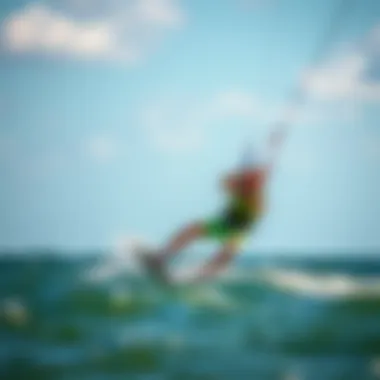
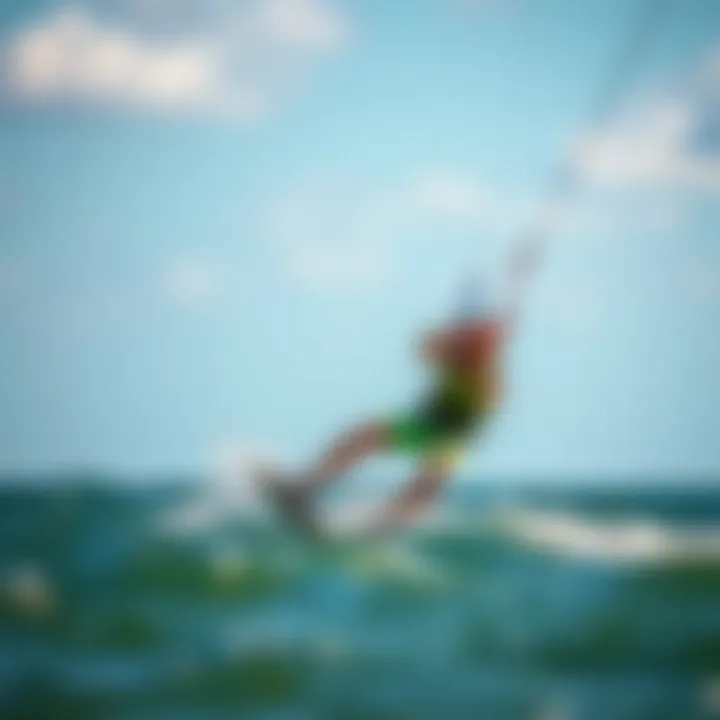
Intro
Kiteboarding, a blend of surfing and paragliding, demands not just skill but also the right gear. Kite surfing vests, often viewed as mere accessories, actually play a pivotal role in ensuring both safety and comfort. With the waves crashing and the wind howling, skimming across the surface requires an understanding of the equipment you’re using—and the vest is no exception.
This article aims to unravel the multifaceted world of kite surfing vests and their significance within the kiteboarding community. Whether you're just dipping your toes into the sport or you're already carving out waves like a pro, comprehending the essentials of kite surfing vests will enhance your experience significantly. We're going to explore various materials, designs, and key features that directly impact performance and safety. Hold tight, as we navigate through this guide together.
Gear and Equipment
In the realm of kiteboarding, equipping yourself with the right gear is non-negotiable. Vests are not just pieces of clothing; they embody a combination of safety features, support, and comfort tailored for your kiteboarding escapades.
Essential Kiteboarding Gear for Beginners
Newcomers to kiteboarding often find themselves overwhelmed by the myriad of choices available. However, some essential pieces of gear cannot be overlooked:
- Kite Surfing Vest: Ensure it fits snugly yet comfortably. A vest that flaps around in the wind is more a hindrance than a help.
- Kite: Choosing the right type and size of kite is crucial. Ideally, beginners should go for a larger, stable model to facilitate smoother take-offs and landings.
- Harness: This not only links you to the kite but also helps distribute the pull across your body, making it easier to handle the power of the wind.
- Board: A shorter board can be more maneuverable, while a longer one tends to be more stable for those just starting out.
Advanced Equipment for Experienced Riders
For those who’ve graduated from being a novice, advanced gear becomes key to elevating your performance:
- Customized Vests: Look for vests equipped with flotation materials that enhance buoyancy without sacrificing freedom of movement.
- Specialty Kites: Depending on your style—be it freestyle, wave riding, or racing—different kites are crafted to enhance specific techniques.
- Surfboards: Performance-oriented boards, often constructed from lighter materials, allow for agile maneuvers and higher speeds.
Remember: Investing in quality equipment can make a world of difference in your experience on the water. You don’t want to skimp on safety.
Techniques and Tips
The technical side of kiteboarding encompasses not only gear choice but also skill development and safety measures. By honing these elements, you can ensure a more enjoyable and secure experience.
Safety Practices for Kiteboarding
Safety should always be your first priority. Regardless of your skill level, adhering to safety practices can prevent mishaps:
- Check Equipment: Before every session, conduct a thorough check of your gear.
- Learn Wind Patterns: Understanding wind dynamics can set you up for success—knowing when to launch and land is critical.
- Wear Safety Gear: In addition to your vest, consider a helmet and impact shorts for additional protection.
Training Techniques to Improve Your Skills
As with any sport, practice is key. Here are some methods to elevate your kiteboarding game:
- Take Lessons: Professionals can provide insight and techniques tailored to your skill level.
- Join a Community: Engaging with other kiteboarders can offer tips and instant feedback.
- Watch Tutorials: Video resources on platforms like YouTube can be priceless in grasping complex maneuvers.
Investing time and resources into these practices can drastically improve your performance and enjoyment in the sport. The journey of mastering kiteboarding may seem daunting, but with the right tools and knowledge, you can become an adept rider, all while ensuring your safety.
As we explore the essentials of kite surfing vests, remember that knowledge is your best companion in this exhilarating adventure.
Prelims to Kite Surfing Vests
Kite surfing vests are more than just pieces of fabric we wear while skimming across the waves; they serve as a vital component in the kiteboarding experience. With their roots deeply embedded in the evolution of water sports gear, these vests have undergone significant transformations. They are designed not only to enhance one’s performance but also to provide essential safety features critical in this action-packed sport. Understanding the nuances of kite surfing vests is paramount for anyone looking to enjoy kiteboarding, be it a novice trying out their first jump or an experienced rider mastering tricks offshore.
The importance of these vests can’t be overstated. As kiteboarders, we are constantly battling the forces of nature. The right vest provides buoyancy, which can mean the difference between a thrilling ride and a possibly dangerous situation in the event of a mishap. They come equipped with features that allow for freedom of movement while offering protection against impacts and other hazards that kite surfers might encounter on the water.
The Evolution of Kite Surfing Gear
The journey of kite surfing gear from its humble beginnings to today is a testament to innovation driven by necessity. In the early days, simplicity ruled; boards were largely rudimentary, and safety gear was nearly nonexistent. However, as kite surfing gained popularity in the 1990s, the challenges of bigger waves and stronger winds highlighted the need for specialized safety equipment.
Vest designs have evolved from thick, bulky garments to sleek, streamlined forms that prioritize comfort without sacrificing safety. Modern vests are crafted from high-tech materials that provide buoyancy and impact resistance, addressing the particular needs of kiteboarders. To put it simply, they have come a long way—much like kiteboarding itself.
Why a Vest is Necessary
When the wind picks up and waves swell, kiteboarding can become a test of skill and endurance. A vest isn't just an accessory; it's a crucial piece of safety gear. Here are some key reasons why wearing a vest is non-negotiable in kite surfing:
- Buoyancy: Vests provide essential flotation, crucial if a rider becomes unconscious or disoriented after a fall.
- Impact Protection: They guard against the hard knocks that can occur during jumps or accidents, reducing the chance of injuries.
- Stability: Wearing a vest can improve a rider's posture and keep them stable, enhancing performance on the water.
- Storage: Many vests come with pockets for small essentials like tools or a phone, integrating functionality with safety.
A kite surfing vest is more than just a precaution; it's an investment in safety. Understanding their dynamic role contributes to safer and more enjoyable kiteboarding adventures. Whether you're cruising along the shoreline or tackling waves at your local beach, having the right vest can make all the difference.
Components of Kite Surfing Vests
When it comes to kite surfing, the right vest can make a world of difference. Understanding the components of kite surfing vests is essential for enthusiasts looking to enhance their safety and enjoyment while breezing through waves. There are various crucial elements at play here, ranging from the materials used to the design features that cater to kiteboarders' specific needs.
By dissecting the components of these vests, adventurers can make informed decisions on suitability, comfort, and performance while out on the water. Knowing what to look for will aid in maximizing both safety and fun in the exhilarating sport of kiteboarding.
Material Types
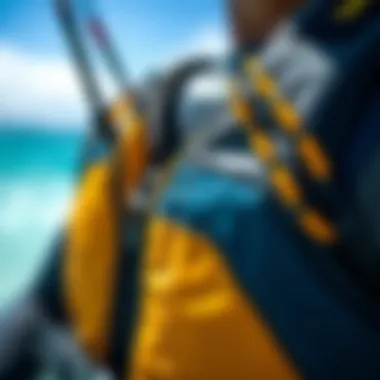
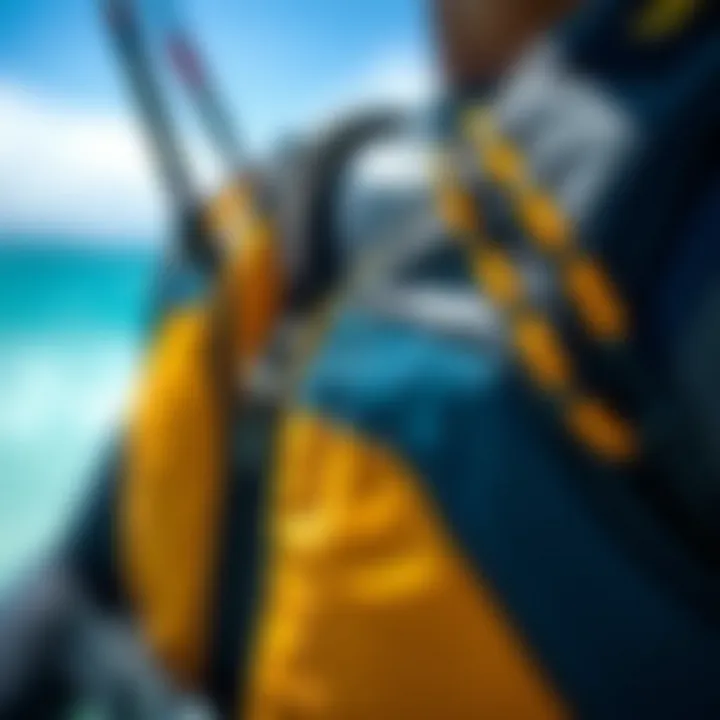
Neoprene
Neoprene is renowned in the water sports industry for its unique properties. It has an impressive ability to insulate and keep the body warm, making it an excellent choice for kite surfers who often face chilly currents. Its elastic nature also lends itself to comfort and flexibility. This means that kiteboarders can twist and maneuver without feeling restricted.
However, neoprene can have its downsides. For instance, it tends to retain water. After a tumble, a vest made of neoprene can feel heavier as it absorbs water, which may not be ideal during long sessions. Yet, it remains a favorite among kite surfers looking for thermal protection and comfort during colder conditions.
Polyester
Polyester is another common fabric choice, especially appreciated for its lightweight and quick-drying properties. It offers good resistance to the sun's UV rays, keeping kite surfers protected during extended outings. This type of material is favored by many due to its breathability and the ability to dry off shortly after being drenched.
Nevertheless, polyester does not provide the same level of insulation as neoprene. In cooler weather, this lack can pose a challenge, as kite surfers may feel the chill sooner than those wearing neoprene. But for those in warmer waters, polyester is an excellent option that merges comfort with sun protection.
Foam
Foam is typically used as padding within vests, contributing to buoyancy and impact protection. The lightweight nature of foam allows it to absorb shocks without weighing the kiteboarder down. Its function as a cushioning material helps mitigate the effects of falling or crashing onto the water's surface.
The downside of foam is that if it's not of high quality, it can lose its shape over time, reducing its effectiveness. A well-designed foam packaging, however, ensures both comfort and resilience, providing kiteboarders with the supportive experience they need.
Design Features
Buoyancy
The aspect of buoyancy is paramount in kite surfing vests. A vest that floats well provides essential flotation, which can be a lifesaver during unexpected falls. Buoyancy contributes not only to safety but also to the confidence of the rider, knowing they will remain afloat even in challenging conditions.
However, too much buoyancy can lead to an ungainly feeling that hinders movement. Thus, finding balance between enough flotation and comfort is key when selecting a vest. Ideally, kite surfers should choose a vest that provides optimal buoyancy without compromising agility.
Adjustability
An adjustable vest is a necessity for kite surfers looking for the best possible fit. Adjustable straps ensure that the vest hugs the body securely without feeling constricting. A snug fit enables better control during maneuvers and can prevent the vest from riding up or shifting around, which can be uncomfortable and distracting.
On the flip side, some may find that too many adjustment points can complicate the dressing process. A simple design that facilitates easy adjustment without sacrificing functionality is what most kiteboarders should aim for.
Cut and Fit
The cut and fit of a kite surfing vest are vital for ensuring ease of movement. A well-designed vest accommodates the kinetic actions of kiteboarding, allowing for freedom in the shoulders and torso. Ideal cuts may vary between brands and styles, but they generally prioritize sleekness while also providing coverage and protection.
Poorly cut vests can result in chafing or discomfort, which could sidetrack a kiteboarder’s focus. Therefore, it’s beneficial to seek out vests reported to have ergonomic designs that cater to active water sports participants. Optimal fit and cut lead to a comfortable and enjoyable kiteboarding experience.
Safety Considerations in Kite Surfing
Safety should always top the list when kiteboarding. The thrill of riding the wind and waves comes with its fair share of risks, and that’s where kite surfing vests come into play. Their widespread use isn’t just a trend; they’re vital for enhancing safety, comfort, and performance on the water. It’s essential for everyone involved in this exhilarating sport to understand the multiple layers of protection that a well-chosen vest affords.
Impact Protection
One of the most compelling features of kite surfing vests is their ability to absorb and mitigate the impacts often encountered during kiteboarding. Whether a rider takes an unexpected fall or collides with equipment or even another person, a vest acts like a shield. The primary materials used in the construction of these vests—neoprene and foam—work in tandem to absorb sudden shocks, reducing the risk of injury.
For example, when a kiteboarder performs jumps, the landing can sometimes be hard, sending shockwaves through the body. Having a vest can cushion these landings significantly. Many vests are designed with specific zones of padding, focusing on areas most prone to injuries, such as the ribs and back. Riders can feel more secure, allowing them to push their limits without the constant worry of serious harm.
In addition to cushioning, some vests incorporate advanced technologies and features like impact-resistant foam that meets or exceeds safety standards. This ensures riders can enjoy their time on the water while knowing they’ve got a reliable layer of protection. Additionally, many products undergo rigorous testing for durability and effectiveness in real-world conditions. Moreover, medical studies note that even minor impacts can lead to cumulative injuries over time—an added reason to prioritize impact protection.
Visibility and Identification
Another safety element linked to kite surfing vests is visibility. Wind and water sports can create a dynamic and sometimes chaotic environment. It’s crucial for kiteboarders to be seen by others in the water, be it fellow riders, boaters, or jet skiers. Many modern vests are crafted with bright colors and reflective materials, making them stand out against the backdrop of water and sky.
Furthermore, some models come with additional features like pockets for identification or emergency whistles. This can be crucial if something goes awry. In the unfortunate event of an injury or an emergency, being identifiable to rescue services is vital.
It's worth remembering that visibility doesn't just mean being seen—it means being recognized. A kite surfer in a vibrant vest is much easier for others to spot. Practical visibility translates directly into safety, reducing the chances of accidents on the water. Riders may want to choose vests that offer a clear space for attaching reflective markers or even personal flags if they’re heading into crowded waters.
"In the fast waters of kiteboarding, being seen can be as important as being safe. Choose your gear wisely."
As the sport evolves, so does the importance of safety gear. It’s not merely about protection from falls but ensuring that every rider enjoys the thrill and excitement of kiteboarding without compromising their safety. Always make informed choices when selecting the right vest, keeping in mind the dual functions of protecting the body and enhancing visibility.
Choosing the Right Kite Surfing Vest
Selecting the correct kite surfing vest is not merely a matter of aesthetics or brand recognition, but a significant decision that can greatly impact safety, comfort, and overall performance on the water. The right vest ensures that you are protected while still allowing for mobility and ease when maneuvering on your board. Also, is there anything worse than being out on the waves, feeling restricted by your gear? In this section, we'll explore key components to consider when purchasing a vest, including sizing, fit, and how your current skill level should influence your choice.
Sizing and Fit
When it comes to sizing of kite surfing vests, think of it like finding the right pair of shoes—fit is critical. An ill-fitting vest can be darn right uncomfortable, leading to chafing or, worse, restricting motion when you need it most.
Typically, sizes are defined by chest measurements, but each brand might have slight variations. Therefore, it's highly recommended to refer to each manufacturer's size chart before you make a purchase.
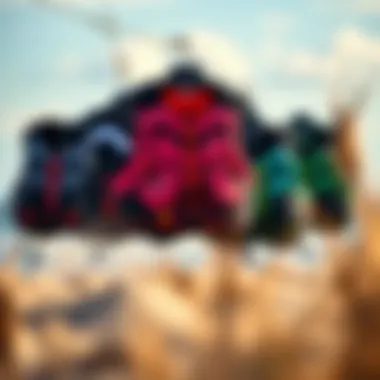

- Room to Move: Ideally, you should be able to raise your arms freely. If your vest prevents you from doing this, it’s time to consider a different size.
In addition to measurement, the type of cut can significantly affect comfort. Some vests feature a more relaxed fit, which can be ideal for beginners, while performance vests are designed to hug your body closely, enhancing agility and responsiveness. One size might fit all, but not in the case of kite surfing.
Choosing Based on Skill Level
Your skill level is a crucial factor when selecting a kite surfing vest. Beginners, intermediates, and advanced kiteboarders have disparate needs which should be adequately addressed in their gear.
- Beginners: If you're just starting out, prioritize comfort and safety over everything else. A flotation vest that is bulkier but forgiving may be the right choice. It should offer ample buoyancy to help you stay afloat, even if you find yourself in the drink unexpectedly.
- Intermediate Riders: At this stage, you’ll be looking for a balance between comfort and performance. A vest that offers decent impact protection without compromising your movement becomes essential. Look for added features like key pockets or attachment points for your gear.
- Advanced Kiteboarders: Here, performance is paramount. Opt for vests crafted from lightweight materials that offer minimal drag in the water. Advanced vests often include specialized foam for impact protection but reduced bulk for optimal flexibility on the board.
Features to Look For
When selecting a kite surfing vest, understanding the various features that can enhance your experience on the water is critical. The right vest can significantly impact your comfort and safety while kiteboarding. It’s not just about looking snazzy; it’s about functionality and practicality that keep you safe and give you the confidence to ride the waves.
Pocket Designs and Utility
One of the first features to consider is the pocket designs incorporated into kite surfing vests. The utility of a vest is heavily influenced by how well it can accommodate your gear. Think about it — having a quick-access pocket can make or break your ride.
- Size Matters: Look for vests that offer pockets adequately sized for essentials like your phone, keys, or a small first-aid kit. A shallow pocket might hold a few coins, but a deeper, secure one can safeguard your tech while still allowing expedient access.
- Placement: The location of the pockets is also important; pockets that are easy to reach while maintaining good aerodynamics are ideal. Keep an eye out for vests that place pockets on the front or accessible side where you won’t have to stretch or twist awkwardly to reach them.
- Water Resistance: Another handy feature in pocket design is water resistance. If you’re carrying items that can’t get wet, look for vests with sealed or water-resistant pockets. For instance, a waterproof pocket might keep your phone dry even during unexpected splashes or a sudden dunk.
- Quick Closure: Vests with magnetic or Velcro closures enable swift access and secure your belongings more efficiently than standard zippers in windy conditions.
In addition to these practicalities, think about how the pockets can add utility beyond storage. A vest with mesh pockets provides ventilation for wet items or gear that needs to dry out.
Attachment Points for Accessories
Beyond pockets, the attachment points for accessories on your vest make a world of difference. Essentially, these are your practical connectors, allowing you to customize your vest for your needs.
- D-Rings and Loops: Look for vests equipped with D-rings or loops. They allow you to snap on items like whistles, lanyards, or small waterproof bags. Being able to securely attach gear prevents loss and saves time.
- Versatile Attachment Locations: Consider how many and where these attachment points are located. Vests that offer multiple attachment options around the chest or sides give you flexibility to adjust how you carry your navigation tools or safety devices.
- Compatible Accessories: Some vest models come with clips designed for specific accessories, like a hydration bladder. If you’re planning on long sessions out on the water, staying hydrated is critical, and having easy access to water can make a big difference.
- Secure for Safety: It's not just about convenience; the attachment points should also keep your equipment secure during accidents or wipeouts. Gear flailing about due to loose attachment points can be risky for both you and those around you.
These features, while often understated, can transform a good day kiteboarding into a truly exceptional one. When shopping for a kite surfing vest, prioritize these aspects to ensure that not only do you have a vest that fits well but one that also empowers you in your adventures. Adapting your gear to fit your specific needs can boost your confidence when you take off into the wind.
Understanding Regulations and Standards
The landscape of kiteboarding is one filled with awe-inspiring moments, but it also comes with its share of risks. Understanding regulations and standards related to kite surfing vests is crucial for safety and ensuring compliance with local laws. This section sheds light on the best practices governing the use of vests, nudging kiteboarders to make informed choices, ultimately enhancing their on-water experience.
Nautical Safety Standards
Nautical safety standards are the backbone of safe kite surfing practices. They encompass rules set by various maritime authorities and are often aligned globally by organizations such as the International Organization for Standardization (ISO). These standards ensure that all safety materials, including kite surfing vests, possess certain performance qualities and durability.
Some key points include:
- Buoyancy Levels: Safety vests need to provide adequate buoyancy, often defined by weight categories to accommodate different body types. This ensures that the vest will keep the rider afloat should they find themselves in trouble in the water.
- Impact Resistance: Vests must meet specific impact resistance criteria to protect against the force of sudden impacts with water or equipment. Look for information displaying compliance with standard such as ISO 12402.
- Visibility: Bright colors and reflective material enhance visibility, contributing significantly to safety. A vest falling short in this area could spell trouble, especially when conditions are less than ideal.
"Safety regulations aren’t just annoying rules; they act as navigational aids, pointing kiteboarders towards safer practices."
Every kiteboarder should familiarize themselves with these standards, as they are not merely bureaucratic red tape, but rather lifelines that can enhance their performance and safety on the water.
Country-Specific Regulations
Diving deeper, one must recognize that the biggest waves often come from locality. Each country may implement its own set of regulations concerning sporting activities, hence the need for kiteboarders to be well-versed in the governing laws applicable to their region. Having local knowledge can prevent potential fines or, worse, dangerous situations.
Here are some considerations:
- Age Restrictions: Some countries might enforce age limits on kiteboarding and the wearing of certain safety gear. It's important to check whether there’s a specific age requirement to ensure compliance.
- Equipment Inspection: In some regions, kite surfing gear must pass inspections before being deemed safe for use. This could include an evaluation of the vest’s buoyancy and general wear and tear.
- Permit Requirements: Certain areas may necessitate permits to kiteboard legally, and adherence to safety gear stipulations, including the use of vests, might be part of these regulations.
Kiteboarders should consider visiting official websites such as boatingwell.org or local government portals that outline safety regulations. By understanding the specific rules that apply, athletes can not only stay compliant but also promote a culture of safety within the kiteboarding community.
Maintaining Your Kite Surfing Vest
Maintaining your kite surfing vest is more than just keeping it looking fresh; it’s about ensuring safety, performance, and longevity. A well-maintained vest can be the difference between a leisurely day on the waves and finding yourself at odds with unpredictable conditions. Here are a couple of key elements to consider when it comes to taking care of this essential piece of gear. It’s an investment, and like any solid investment, it demands upkeep.
Cleaning Guidelines
Cleaning a kite surfing vest isn’t rocket science, but it should be done with care. Saltwater, sand, and sunscreen can build up, affecting not only the material but also your comfort and safety.
- Rinse It After Use: Always rinse your vest in fresh water after every session. Salt and sand can corrode materials over time. A quick rinse ensures that grime doesn’t take root.
- Gentle Soap: Use a mild soap for deeper cleans. Harsh detergents can damage the fabric. A few drops of laundry detergent mixed in warm water should do the trick.
- Air Drying: Avoid the dryer. Let it air dry in a shaded place. Sun exposure might be good for your tan but not for the vest’s integrity.
By being consistent with these cleaning steps, you not only extend the life of your vest, but you will also keep it smelling fresh and functional.
Storage Recommendations
Storing your vest properly can also significantly affect its lifespan. Just like you wouldn't leave a fine suit or a vintage watch carelessly tossed aside, your kite surfing vest deserves a bit of love too.
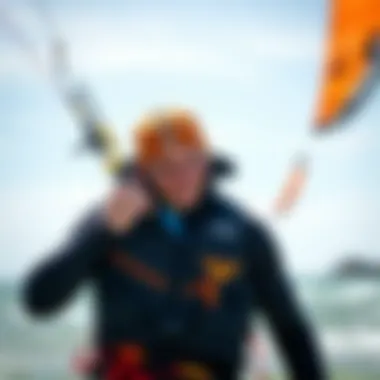
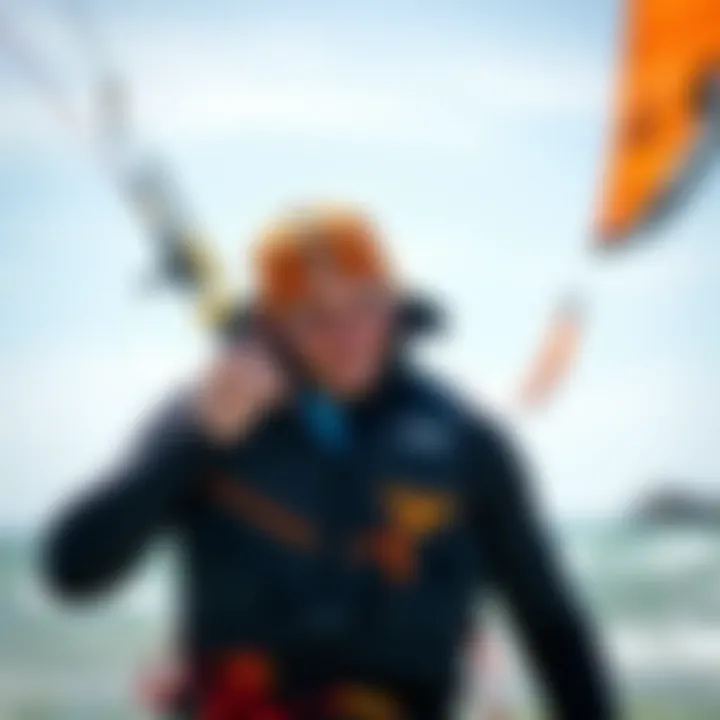
- Dry Storage: Make sure your vest is completely dry before storing it. Moisture can lead to mold and mildew, and nobody wants that.
- Avoid Heavy Items: Don’t stack heavy gear on top of it while in storage. This can warp the vest's shape and reduce its effectiveness in a pinch.
- Keep it Cool: A temperature-controlled, dry environment is ideal. Hot attics or damp basements are not the best.
- Use a Hanger: If possible, hang the vest. This keeps it from developing creases or permanent bends.
By adhering to these guidelines, you’ll not only maintain the aesthetic appeal of your vest but also ensure that it serves you well for countless kite surfing adventures.
"A little attention goes a long way; taking care of your gear means more fun on the water and fewer worries about what lies beneath it."
Common Misconceptions About Vests
Kite surfing vests often face a smorgasbord of misunderstandings. These inaccuracies can cloud the judgment of both newcomers and seasoned kiteboarders alike. By dissecting these misconceptions, we can better appreciate the significance of this gear in our adventurous escapades on the water.
The Myth of Over-Reliance
One of the more common myths surrounding kite surfing vests is the idea that they create a false sense of security, leading to over-reliance among riders. The belief here is simple: once a vest is donned, a kiteboarder might feel invincible and disregard other vital safety practices. This notion, while understandable, lacks nuanced perspective.
Kite surfing vests are first and foremost designed to augment safety—not replace the fundamental skills and awareness required in kiteboarding. Much like wearing a seatbelt doesn't mean you should ignore the rules of the road, a vest does not grant immunity against waves, winds, or other hazards. Knowledge, experience, and a healthy dose of caution remain paramount.
Thus, using a kite surfing vest can indeed bolster safety, providing buoyancy and impact protection, but it should be employed as a supplementary tool in a wider toolkit of safety measures. Riders should still consistently assess environmental conditions, remain vigilant of their equipment, and practice appropriate kite handling techniques.
Effectiveness in Varied Conditions
Another glaring misconception is that kite surfing vests are only effective in specific conditions, often limited to calmer waters or light winds. This view not only underestimates the adaptability of modern vest designs but also ignores the evolving nature of kite surfing as a sport. In reality, various vests are engineered to perform well across a spectrum of conditions.
For instance, some vests feature enhanced flotation properties perfect for choppy waters, while others come equipped with reinforced padding to absorb impacts during jumps or when crashing hard. High-quality vests allow for free movement and can be suited for both flat-water sessions and the exhilarating challenges of wave riding.
Here's a breakdown of how different conditions determine vest utility:
- Choppy waters: Opt for a vest with superior buoyancy that helps keep you afloat. These generally have a snug fit, minimizing excess materials that might hinder performance.
- Strong winds: Consider lighter vests made of materials that offer flexibility without sacrificing safety, allowing for more dynamic movements.
- Surf and wave riding: A vest with solid impact protection is crucial since fall and crashes are more common in these situations.
Ultimately, the right vest will cater to individual riding styles and environmental challenges, debunking the myth that they are only suitable for limited scenarios. Each rider must choose a vest appropriate for their specific needs, ensuring safety and confidence while tackling any kite surfing conditions.
"Safety doesn’t stop at gear, it starts with education and experience. Use vests to enhance, not substitute, your skills on the water."
By addressing these common misconceptions, it becomes clear that kite surfing vests are indispensable allies on the water, catered to bolster a rider's safety without engendering complacency.
The Future of Kite Surfing Vests
The horizon of kiteboarding gear is as dynamic as the sport itself, and kite surfing vests are no exception. Understanding the future of these vests isn’t just for gear aficionados; it’s crucial for anyone who wishes to navigate the winds safely and effectively. As technology advances and materials evolve, the roles that these vests play will shift, bringing safety, performance, and comfort to new heights. Both novice and seasoned kiteboarders will benefit from keeping tabs on emerging trends that frame the future of this essential gear.
Innovations in Material Science
Material science is stepping up, reshaping the kite surfing vest landscape with exciting advancements. For starters, imagine a vest that is not only buoyant but also remarkably lightweight. New composites and fabrics are being developed, offering both enhanced durability and reduced weight, which is particularly valuable for long sessions on the water where fatigue can easily set in.
- Nano-Coating Technologies: These slim coatings can render fabrics nearly waterproof while maintaining breathability—this means you stay dry without feeling like you’re in a sauna.
- Smart Fabrics: These fabrics can sense environmental changes like temperature and moisture levels, adapting their properties accordingly. That could mean better insulation on a chilly day or increased airflow when the sun is blazing.
- Biodegradable Materials: There's a growing push towards eco-conscious choices. New materials made from organic compounds could soon reduce the environmental impact of kiteboarding gear significantly.
By continually assessing the options available, kite surfers can find vests that not only improve their performance but also align with sustainable practices.
Smart Technology Integration
As the sport evolves, the integration of smart technology in kite surfing vests is becoming more prevalent. This isn't just about fancy gadgets; it’s about maximizing safety and performance through innovative solutions.
- GPS Tracking: Imagine a vest that integrates directly with your device, providing navigation assistance while you're out riding the waves. This can be critical for tracking your location during a session or even retracing your steps when conditions worsen.
- Impact Sensors: These detect sudden jolts and impacts, keeping track of how much stress the rider's body experiences. This data could help in understanding one’s limits and reduce the risk of injury.
- Communication Systems: Being out on the water can sometimes mean being out of touch. Smart vests equipped with communication systems might allow you to stay connected with fellow kiters, thus enhancing both enjoyment and safety in the sport.
The inclusion of smart technology could redefine how kiteboarders approach safety and performance, taking the sport to a level that has not yet been imagined.
The future of kite surfing vests stands at an intersection of innovation and sustainability. Awareness and adaptation to these changes will not only enhance safety and comfort but will also ensure that kiteboarding remains an exciting and viable activity for years to come. By keeping abreast of these trends, kiteboarders can ensure they are well-equipped for the adventures that lie ahead.
Closure
In summary, kite surfing vests are far more than just an accessory for kiteboarders; they are a critical component of safety and comfort on the water. The myriad considerations that come into play when selecting the right vest—such as material type, design features, and the specific needs based on one’s skill level—highlight the importance of making an informed choice.
When kiteboarding, the unpredictability of open waters and wind conditions calls for reliable gear that enhances both performance and safety. The use of high-quality vests can provide buoyancy and protection against impacts, while also ensuring visibility in crowded waters. Here are some key points to remember:
- Safety Comes First: A well-fitted vest can protect the upper body and offer flotation in emergencies.
- Material Matters: The choice of neoprene, foam, or other materials can greatly affect warmth and flexibility.
- Fit is Crucial: An ill-fitting vest won’t function as intended, so be sure to get an accurate sizing.
- Stay Updated: As regulations evolve, understanding local safety standards can prevent potential fines or issues.
"In every adventure, safety isn't just a precaution; it's the backbone of experience."
Summarizing Key Takeaways
- Functionality: Kite surfing vests serve multiple purposes such as impact protection, flotation, and comfort.
- Material Diversity: Different materials like neoprene or polyester cater to specific performance needs.
- Regulatory Compliance: Awareness of safety regulations ensures that enthusiasts can enjoy kiteboarding without hassles.
- Future Innovations: New technologies in materials and design are emerging, promising further enhancements in gear safety and efficiency.
These components come together to form a comprehensive understanding of what kite surfing vests represent in the sport. They are not just items of clothing; they embody the spirit of safety and adventure crucial for anyone engaging in this exhilarating water sport.
The Ongoing Importance of Safety Gear
The realm of kiteboarding, with its thrilling highs and potential for unforeseen risks, cannot overlook the significance of safety gear. A kite surfing vest not only offers physical protection but also enhances mental readiness. Knowing you are safeguarded against falls or impacts gives one the confidence to push beyond personal limits,
Moreover, the ongoing advancements in safety gear technology—such as the integration of smart features to monitor performance and track health metrics—point to a promising future in ensuring athlete safety while maximizing their experience.
As kiteboarding continues to grow, the fusion of advanced materials with cutting-edge designs will redefine our expectations from safety gear. For enthusiasts, staying informed and prepared equipment-wise is fundamental to not only enjoy the sport fully but also to pursue it reliably with peace of mind.



